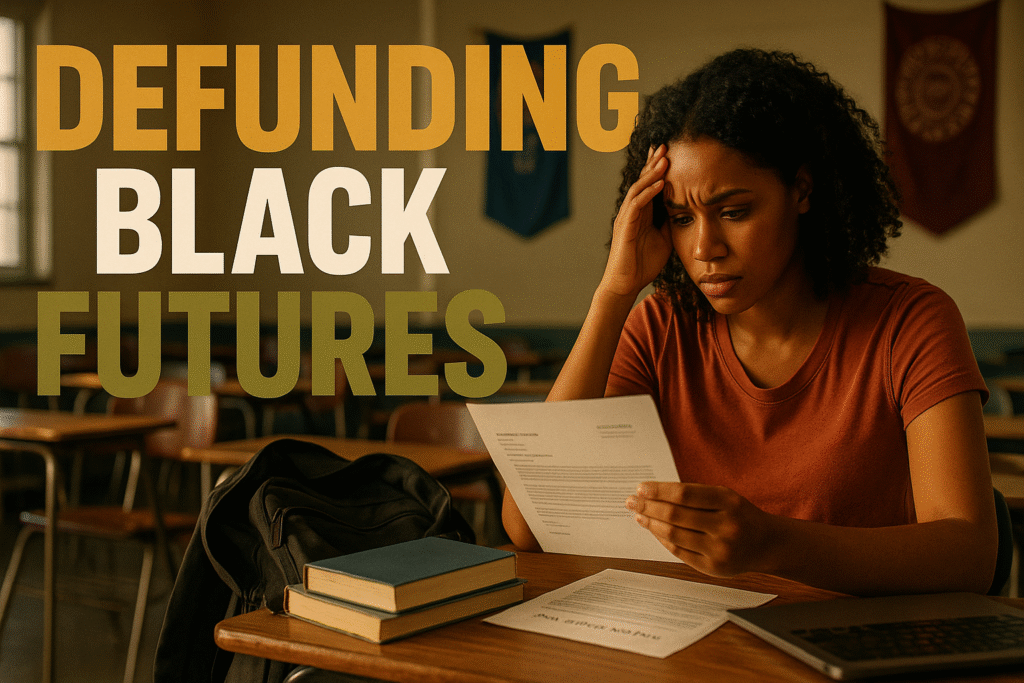

Pell Grant Cuts and HBCUs: How Federal Disinvestment Harms Black Southern Students
The History Behind The Headlines
By Darius Spearman (africanelements)
Support African Elements at patreon.com/africanelements and hear recent news in a single playlist. Additionally, you can gain early access to ad-free video content.
Introduction: Pell Grant Reductions Threaten Access to College for Black Southern Students
Recent reporting and a newly released analysis show that decreases in Pell Grant funding and proposals to change eligibility rules have fallen hardest on Black students, especially at historically Black colleges and universities (HBCUs) and other Southern institutions. Importantly, many Southern colleges serve large populations of low‑income and first‑generation students who rely on Pell. Furthermore, HBCUs operate with smaller endowments and fewer financial reserves. Consequently, when federal aid shrinks, these colleges and their students face immediate damage to access, completion, and long‑term mobility (Times of India: Times of India; Center on Budget and Policy Priorities: CBPP).
Key Terms Infographic: Definitions and Visual Guide for Pell, HBCUs, and Eligibility
Below are concise definitions of the key terms used in this story. They are optimized for mobile viewing. A short infographic follows that presents these definitions visually.
Pell Grant
The federal grant for low‑income undergraduates that does not require repayment. Award size varies; millions rely on it for tuition and living costs (CBPP: https://www.cbpp.org/research/house-budget-committee-plan-cuts-pell-grants-deeply-reducing-access-to-higher-education).
HBCU
Historically Black Colleges and Universities founded to educate Black students. HBCUs serve high shares of Pell recipients and often have smaller endowments, increasing vulnerability to federal funding shifts (White House CEA: https://bidenwhitehouse.archives.gov/cea/written-materials/2024/05/16/the-economics-of-hbcus/).
Eligibility & Full Award
Pell eligibility rules determine award size. Some proposals would require 15 credits for a full award (instead of 12), affecting part‑time, working, and caregiving students and reducing effective support (Washington Post: https://www.washingtonpost.com/education/2025/04/29/house-republicans-student-loans-pell-grant-financial-aid-changes/).
Detailed Analysis of the Current News Story: What the New Study and Coverage Reveal about Pell Cuts
The newest summaries of the report describe declines in Pell funding and awards across the last decade and emphasize that the South — home to many HBCUs — saw disproportionate impacts. Moreover, the analysis notes that when federal aid declines, the consequences are immediate for students who have little family wealth to fill gaps.
Additionally, current federal budget proposals and legislative pushes would change how Pell awards are calculated. For example, proposals to require 15 credit hours for a full award rather than 12 would reduce awards for part‑time or low‑credit students, many of whom are working, parenting, or caring for family. Policy analysts and advocates warn that such rules would shrink the effective support for millions of students and would hit HBCUs and Southern community colleges particularly hard (Washington Post: Washington Post; CBPP: CBPP).
Moreover, state briefs and local reporting illustrate real numbers. In Mississippi, for example, state reporting notes that nearly 80,000 students rely on Pell funds — illustrating how a national change produces large local consequences for enrollment and completion (Mississippi Today).
Historical Context: Pell’s Creation, Declining Purchasing Power, and HBCUs’ Structural Vulnerability
In 1972 Congress established the Basic Educational Opportunity Grant program, later renamed the Pell Grant, to keep low‑income students in college. Over the decades, the federal maximum award rose nominally, but college costs rose faster. As a result, Pell’s purchasing power has declined. Policy analyses estimate the maximum Pell covers roughly 27–30 percent of average public four‑year costs in recent years — far lower than its historical share. Thus, any effective reduction in Pell or policy changes that lower access magnify an already diminished program (CBPP: CBPP).
Pell Coverage vs. Average Public 4‑Year Costs (Illustrative)
HBCUs operate within this constrained funding environment. Historically, Black colleges have smaller endowments and less philanthropic capital than many predominantly white institutions. Consequently, HBCUs depend heavily on federal aid streams — including Pell — to balance budgets and support students. The White House Council of Economic Advisers and other analyses document these structural funding gaps and explain why HBCUs are more sensitive to any decline in federal student aid (White House CEA: White House CEA).
- HBCUs have higher shares of Pell recipients — often around 70–75 percent of their student bodies receive Pell (HBCU News: HBCU News).
- Nationally, millions of undergraduates rely on Pell each year; estimates commonly fall between 6–7 million recipients in recent years (Washington Post reporting on CBO analyses: Washington Post).
Estimated Share of HBCU Students Receiving Pell
Historical Timeline of Pell Support and Policy Changes: Key Moments and Their Effects
First, Pell began as a major expansion of federal support for college in 1972. Over the 1970s and 1980s Pell became central to low‑income college access. Later, inflation and tuition growth outpaced Pell’s increases. As a result, the maximum award covered a declining share of college costs by the 1990s and accelerated into the 2000s. Consequently, policymakers have repeatedly debated whether to adjust Pell for inflation or to reconfigure eligibility rules to reflect today’s labor and enrollment patterns (CBPP: CBPP).
Second, over the past five years federal policy debates have moved from student loan repayment to the design of Pell. Proposals in Congress have included requiring heavier credit loads for full awards and reworking eligibility for part‑time, incarcerated, or short‑term program students. Each change attracts advocacy and pushback because of the unequal harm it imposes on communities already disadvantaged by economic and racial wealth gaps (Washington Post: Washington Post).
Why This Matters Today: Consequences for Black Southern Students and the Black Diaspora
First, access to higher education is directly tied to intergenerational wealth and mobility. Therefore, when Pell shrinks, fewer low‑income Black students can enroll full time, remain enrolled, or complete degrees. This reduces upward mobility across generations, exacerbating racial wealth and opportunity gaps.
Second, HBCUs play a unique role for the Black diaspora. Many HBCUs produce disproportionate shares of Black professionals in STEM, education, and public service. Loss of access at HBCUs or enrollment drops would shrink the pipeline of Black professionals across the economy and erode community anchors. Thus, Pell weakening reduces not only individual opportunity but also community capacity and leadership (HBCU News: HBCU News).
Conclusion: Policy Solutions to Restore Equity in Pell and Protect Black Southern Students
Advocates propose restoring Pell’s purchasing power through inflation‑adjusted increases, expanding eligibility for part‑time students, and targeting supplemental funds to HBCUs to offset structural funding gaps. Furthermore, policymakers can reject proposals that raise the required credit load for full awards without transitional supports for working students. In sum, targeted federal action can prevent a retrenchment of access and ensure that HBCUs and Southern colleges remain engines of upward mobility for Black students (CBPP: CBPP; HBCU News: HBCU News).
Pell Reliance in the South
Mississippi
~79,709 Pell recipients statewide (illustrative figure from reporting).
Alabama
High Pell reliance at community colleges and HBCUs; vulnerable to eligibility rule changes.
Louisiana
Many public colleges with substantial Pell populations; reductions would have local enrollment impacts.
Finally, federal investment in Pell is also an investment in national capacity. Especially now, when labor markets require higher skills, cutting Pell undercuts economic competitiveness and deepens racial inequities in education and income. Therefore, the stakes are not abstract; they are immediate for students, families, campuses, and the communities HBCUs serve (Mississippi Today: Mississippi Today).
Conclusion: Restoring Pell Strengthens Black Student Mobility and Stabilizes HBCUs
Ultimately, Pell is a primary federal lever for higher‑education equity. If policymakers want to protect upward mobility for Black students and strengthen HBCUs and Southern colleges, then maintaining or strengthening Pell is essential. Otherwise, proposed eligibility tightening and effective cuts will reduce enrollment, completion, and long‑term economic gains for the Black diaspora and for whole communities.
For advocates, the task is to link the numbers to moral and economic arguments: preserving Pell equates to preserving community stability, workforce development, and racial equity in education. For campuses, the task is to document local impacts and build coalitions that show how federal policy changes reverberate across families and neighborhoods.
ABOUT THE AUTHOR
Darius Spearman has been a professor of Black Studies at San Diego City College since 2007. He is the author of several books, including Between The Color Lines: A History of African Americans on the California Frontier Through 1890. You can visit Darius online at africanelements.org.
